5
Dismounted Soldier Power and Light Unmanned Aerial Vehicles and Unmanned Ground Vehicles
ENERGY-INFORMED OPERATIONS
While most think of energy in commodity terms—where value is measured purely in terms of quantity—the field of operational energy demands recognition of energy as a differentiated entity. That is, energy comes in many forms, and its diverse attributes—such as density, availability, timing, location, delivery rate, and the ability to modulate—significantly impact value creation in a given application. Most energy programs base their principal metrics on the commodity perspective. In the Department of Defense (DoD), this focus translates to an enterprise emphasis on flight operations (the largest operational consumer of energy); ground operations in which armored vehicle consumption dominates during maneuver, and stability operations ensuring base-camp sustenance. However, the Army’s primary mission is not to save money; it is to prevent and/or win wars. As SLA Marshall famously observed in 1950, repeated by military scholars, and reiterated by McManus in 2010, “Wars are won on the ground, usually by small groups of fighters, who require considerable logistical, firepower, and popular support.”1 On a comparative basis, dismounted Soldier energy consumption is miniscule when compared to jet fighters and tanks. However, if these observations are valid, then the military’s energy focus must not be dictated by the
___________________
1 J. McManus, 2010, Grunts: Inside the American Infantry Combat Experience, World War II through Iraq, Penguin Random House, https://www.penguinrandomhouse.com/books/302305/grunts-by-john-c-mcmanus/.
heaviest use; rather, by an understanding of how energy plays in the U.S.’ operational advantage.
Marshall, of course, took substantial personal risk and invested extensive effort to examine factors that influence the Infantryman’s combat capability. His work informed subsequent analysis on factors associated with cognitive condition, focus, motivation, and other factors that determine whether U.S. ground Soldiers need 10:1 numerical superiority, or if they can win with a 1:10 disadvantage.2 Inevitably, energy is a key determinant in these factors. In a simple illustration, Soldier-carried technology can provide navigation, awareness, and communication, but energy must provide adequate, reliable power with the flexibility to select and prioritize the use (without distracting the Soldier). The lesson, however, is not simply to ration energy—any more than ammunition can be rationed. The obvious metrics are not only “how much energy is used,” but also “how can one maximize the operational benefit of energy?” In fact, this is the crux of “Energy-Informed Operations,” captured in Army Operational Energy policy, which asserts the goal to manage energy to provide the greatest operational benefit.3
While past analyses focused directly on the Soldier and things they carry, modern technologies have uncovered powerful new opportunities to extend Soldier capabilities by projecting their senses and zone of influence. For 21st century operations, U.S. Soldiers have increasingly employed remote sensors, unmanned systems, and improved analytical tools to dramatically increase Soldier effectiveness. Like dismounted Soldiers, unmanned sensors and platforms use relatively small quantities of energy, but their attributes of flexibility, range, duration, interoperability, management capability, and so on determine operational contribution. Unlike any manned operation, these systems typically do not need replenishment of water, food, mail, or other logistics—other than energy.
Thus, energy becomes a dominant consideration: energy effectiveness (driving range, update frequency, etc.) and operating life—or the ability to replenish the supply—significantly determine the operational utility. Energy is fungible; it can be transformed as needed to power systems for sensing, processing, communicating, or propulsion. Even a low-powered device such as an unmanned ground sensor would benefit from a long-endurance source, either local or highly energy dense. Otherwise, these distributed sensors ultimately must be physically revisited for replenishment or replacement—hardly a stealthy or effective use of Soldiers.
Conclusion: The demands of the future operating environment (smaller formations supported by logistical and fire support) indicate that the
___________________
2 Ibid.
3 Secretary of the Army, Army Operational Energy Policy Memorandum, April 20, 2013, https://api.army.mil/e2/c/downloads/295964.pdf.
Army’s power and energy (P&E) efforts should be focused less on heaviest power draw and more how P&E will support a distributed force structure.
GROWING WEIGHT PROBLEMS AND DEMANDS ON THE SOLDIER
As new technical capabilities have become available, they often have increased the weight burden carried into battle by the dismounted Soldier. Although dismounted soldiers are limited by what they physically carry into battle, it has been commented that with respect to new hardware, the soldier is often treated like a “Christmas Tree” with new ornaments added yearly (see Figure 5.1 for a list of a typical equipment load and correlated weight).
A 2013 Army study of dismounted operations in Afghanistan found that, across all infantry positions, the average load on a soldier was more than the 50 lb. Army target (see Figure 5.2). Past research studies frequently have tied heavier loads to slower soldier movement but missed the link between heavier weight burden and other measures of operational effectiveness, such as combat readiness, situational awareness, marksmanship, maneuver, and exposure to enemy fire. Not only does this increased load limit the dismounted soldier’s operational effectiveness, but it has significantly increased the number of injuries incurred. As a result, weight is a major consideration for dismounted P&E systems.
Batteries represent a significant portion of the dismounted soldier’s weight burden. In Afghanistan, the average weight of batteries carried by U.S. Army combat personnel was 4.5 kg (10 lb) with some soldiers carrying 11.7–13.2kg (26–29 lb) depending on their battlefield role (see Figure 5.1).4
Soldier Silent Power (Thermophotovoltaic Devices)
A promising Soldier Silent Power (SSP) concept is the thermophotovoltaic generator that generates photons by combusting a fuel to heat an emitter and converting these photons to electricity via a photocell. Such a system has been under development at the Massachusetts Institute of Technology, first in the Laboratory for Electromagnetic and Electronic Systems, and currently in the Institute for Soldier Nanotechnologies.5 It is a micro-combustor that heats a nanophotonic material to incandescence.
___________________
4 Thales Group, “Reducing the Battery Burden on the Dismounted Soldier,” https://www.thalesgroup.com/en/global/presence/europe/united-kingdom/defence/land-systems/soldier-systems/squadnet/reducing-battery, accessed January 2021.
5 W. Chan, I. Celanovic, and J. Joannopoulos, 2020, “Silent Lightweight Battlefield Power Source: Scalable from Soldier Wearable Power to Platform Power,” white paper presented to the study committee, Massachusetts Institute of Technology Institute for Soldier Nanotechnologies.
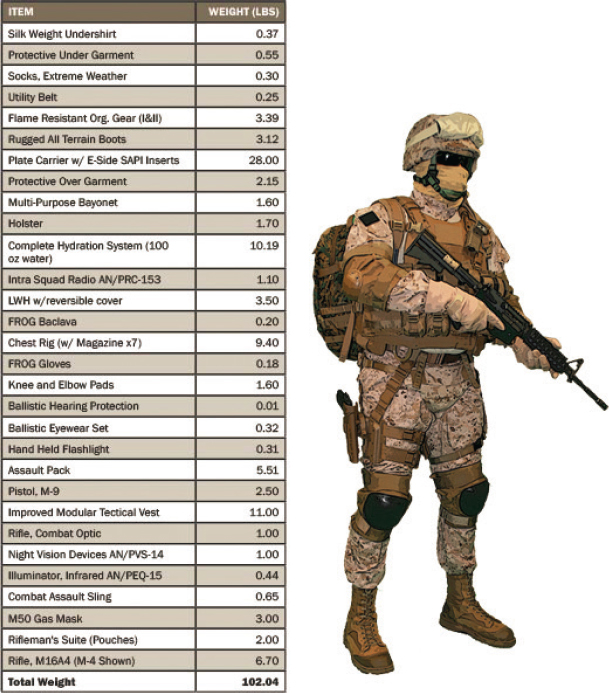
The nanophotonic material (a unique photonic crystal that enables control of the spectrum of emitted radiation) is engineered to emit certain preferred wavelengths of light when heated. The emitted light (whose hemispherical capture is greater than 70 percent) drives an optimized photovoltaic (PV) cell to generate electricity. This approach is significantly more efficient than traditional thermophotovoltaics because the light emitted by the nanophotonic material has a near perfect match to the PV cell to generate electricity, as indicated in Figure 5.3.
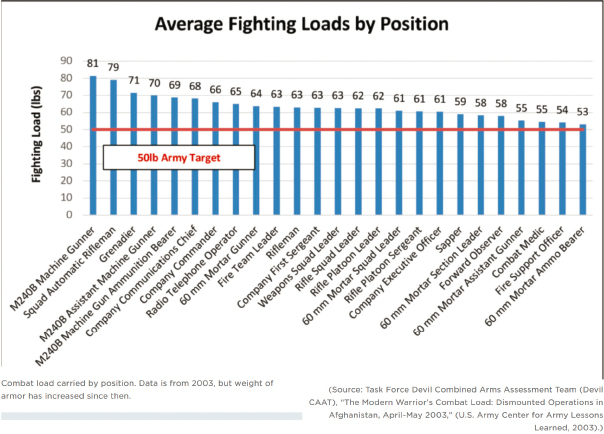
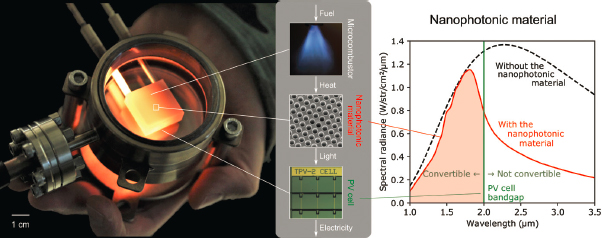
Energy generated from the thermophotovoltaics are then stored in an intermediary battery that acts as buffer between generation and the actual application use. This enables the ability to provide short-term power that exceeds the average power generation from the thermophotovoltaics.
Hydrocarbon fuels still have several fundamental advantages over all battery systems, among them a much higher specific energy. The SSP currently in development would use hydrocarbon fuels and provide both logistic and operational advantages, such as the following:
- For a combustion system, only the fuel needs to be stored, because air is taken from the environment and reaction products are released into the atmosphere. The burning of 1 kg of fossil fuel requires 15 kg of air but uses air that does not require delivery.
- Military standard jet propellant 8 (JP8) fuel is relatively safe because it is hard to ignite.
- Refueling with JP8 is a quick alternative to recharging batteries.
- Because the fuel is energy dense, weight reductions of 75 percent can be achieved.
- The endurance of the system is about 10 times greater than batteries.
- Solid-state design improves reliability over internal combustion engines.
- Multi-fuel operation provides many refueling options.
- A 5-W generator fits in the palm of your hand.
One of the most important benefits of this system is that it can offer 10 times the specific energy of lithium-ion batteries (including fuel and generator weight) and can be made compact in the 10–1,000 W range without loss of specific energy. The generator has virtually no moving parts, resulting in no noise or vibration and a long operation lifetime with low maintenance. Because this device fundamentally uses a heat-to-electricity conversion process, and the fuel is simply burned to generate heat, the generator can work with any fuel, including JP5 and JP8, leading to simplified logistics, improved operational readiness, and cost savings. Compared to fuel cells, this technology offers fuel flexibility because it can convert conventional fuels without a reformer and does not suffer damage by sulfur. Furthermore, liquid fuels have a much lower storage overhead than hydrogen or propane.
Preliminary specifications for SSP systems in two alternative sizes are provided in Table 5.1.
An Armored Brigade Combat Team (ABCT) has 124–157 radios and requires 750–1,000 BA5590 batteries if all radio equipment is in use for 72 hours. This mission length translates to 1,600–2,000 lb. of batteries. If each radio operator were equipped with an SSP, similar to Figure 5.4, the total weight for the ABCT would be 160–210 lb for the SSP and 140–180 lb
TABLE 5.1 Soldier Silent Power Tables
| Preliminary specifications for SSP systems in two alternative sizes are as follows: | ||
|---|---|---|
| Power | 10 watts | 20 watts |
| Duration | 72 hours | 168 hours |
| Specific fuel consumption | 480 g/kWh | |
| Power density | 41 W/kg | |
| Battery energy density | 180 Wh/kg | |
| TPV Generator to Battery Comparison | ||
| Generator weight | 0.5 kg | 0.5 kg |
| Fuel weight | 0.7 kg | 1.6 kg |
| Battery weight | 1.0 kg | 1.0 kg |
| Total TPV System | 2.2 kg | 3.1 kg |
| Equivalent Battery Weight | 8.0 kg | 18.6 kg |
| TPV Weight Savings | 5.8 kg | 15.5 kg |
SOURCE: W.R. Chan, V. Stelmakh, M. Ghebrebrhan, M. Soljacic, J.D. Joannopoulos, and I. Celanovic, 2017, Enabling efficient heat-to-electricity generation at the mesoscale, Energy and Environmental Science 10:1367–1371, doi:10.1039/C7EE00366H.
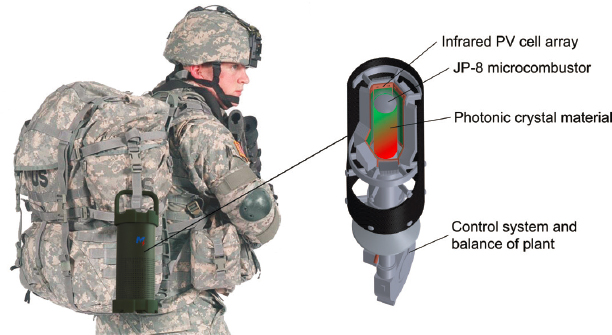
for the JP8 fuel. When the weight savings shown in Table 5.1 are applied across the entire brigade, the total weight reduction would be 1,300–1,700 lb. A significant cost savings also accrues because warfighters would not be discarding nearly full BA5590s because they do not want to risk taking a partially drained battery on a mission.
Some open issues remain to be explored. For example, the fuel-to-electricity efficiency ranges from 10 percent at the 5 W scale to 20 percent at the 100 W scale. Questions such as how to vent such heat on the individual soldier and how this affects a soldier’s thermal signature remains to be explored.6
Finding: Thermophotovoltaic processes represent a promising opportunity in support of the dismounted soldier, while an upsized version might prove attractive for other applications, such as unmanned aerial vehicles (UAVs) and unmanned ground vehicles (UGVs).7 (Tier 2, Lead)
Potential Role of Unmanned “Mule” Ground Vehicles
Extensive use of UGVs, configured as mule vehicles, could further lighten the dismounted soldier weight burden during an extended-length mission by carrying ammunition, food, and water as well as batteries. Significant advances as part of the Army’s small multi-purpose equipment transport (SMET) program have now been made with both wheeled and tracked UGVs, powered by JP8 and capable of carrying up to 450 kg of supplies and/or weaponry over 30 miles a day (see Figure 5.5). These mule vehicles can operate autonomously via plotted waypoints, by remote driving by a human operator, or by a “follow-me” mode that allows the vehicle to track behind a soldier wearing a beacon.8
From a P&E standpoint, the impact of these mule vehicles on dismounted soldiers could be quite significant, providing a mobile station to recharge batteries for radios and similar devices directly from the vehicle. Each SMET is capable of generating 3 kW of electric power when stationary and 1 kW while moving.9
___________________
6 W. Chan, I. Celanovic, and J. Joannopoulos, 2020, “Silent Lightweight Battlefield Power Source: Scalable from Soldier Wearable Power to Platform Power,” white paper presented to committee, Massachusetts Institute of Technology Institute for Soldier Nanotechnologies.
7 See Appendix I for a summary of possible technical challenges.
8 U.S. Army Acquisition Support Center, 2020, “General Dynamics Land Systems Finally Secures SMET Unmanned Ground Vehicle Contract,” Overt Defense, https://www.overtdefense.com/2020/07/20/general-dynamics-land-systems-finally-secures-smet-unmannedground-vehicle-contract/.
9 Army Recognition, 2020, “GDLS Awarded U.S. Army Contract for Increment I of S-MET Small Multipurpose Equipment Transport Program,” July 16, https://www.armyrecognition.com/defense_news_july_2020_global_security_army_industry/gdls_awarded_u.s._army_contract_for_increment_i_of_s-met_small_multipurpose_equipment_transport_program.html.
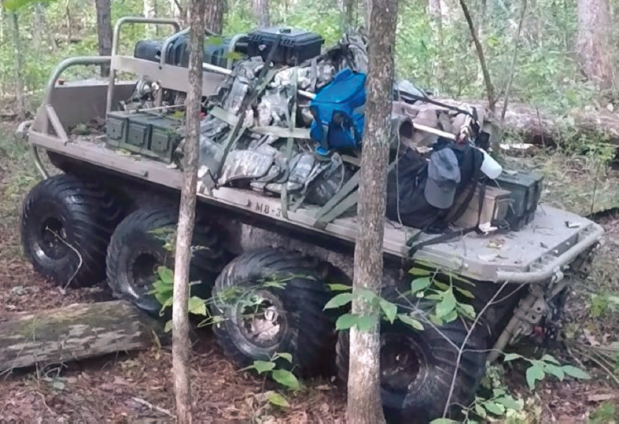
Interestingly, the Army is already working with an outside company to integrate a full 10 kW JP8-based solid oxide fuel cell (SOFC) power system with reformer into a SMET vehicle in 2021. The 10 kW fuel cell is the primary propulsion, hybridized with a battery. A fuel-to-electricity efficiency (including reformer losses) is estimated to be between 30 and 40 percent. This program will demonstrate the capability of full-time silent electrical power generation from JP8.10 There are also larger unmanned vehicles under development now that could export even greater levels of electrical power. Examples include an expeditionary modular autonomous vehicle (EMAV) and a robotic combat vehicle light (RCV-L), both of which can export up to 30 kW of electrical power.11
___________________
10 K. Centeck, U.S. Army Ground Vehicle Systems Center, 2020, email exchange with committee member.
11 Aerospace Manufacturing and Design, 2015, “Pratt & Whitney AM Engine Parts Poised for Entry into Service,” April 6, https://www.aerospacemanufacturinganddesign.com/article/pratt-whitney-additive-parts-engine-040615/.
By periodically swapping an individual dismounted soldier’s rechargeable batteries with an extra set of batteries being recharged and carried on the SMET while it moves, it would no longer be necessary for an individual soldier to carry more than a day or two’s worth of batteries.
Finding: Extensive use of “mule vehicles” from the Army’s SMET program provides an opportunity to recharge soldier batteries on the battlefield while lightening their weight burden, carrying ammunition, fuel, and water as well as batteries. (Tier 1, Lead)
SMALL POWER FUEL CELLS
DoD and Army agencies generally fund the development of small SOFC power systems for operation on logistic fuels under Small Business Innovation Research (SBIR) and Small Business Technology Transfer (STTR) programs. Examples of such programs in the past include the following: design and demonstration of small (250 to 350 W) SOFC units for soldiers, UAVs and UAGs, and communication devices, utilizing micro-tubular SOFCs with propane, butane, or LPG fuel (Adaptive Energy, Ann Arbor, MI); small fuel-cell power systems for use on the iRobot PackBot military robot used by the Army for dangerous tasks, including examining mines and checkpoints, to extend the operational time from 2 h to more than 10 h (Adaptive Energy, Ann Arbor, MI); and small SOFC power systems for portable, remote, and mobile applications operating on liquid fuels such as butanol, gasoline, kerosene, and desulfurized JP8 (Protonex Technology, MA).
Examples of current research solicitations by Army agencies include development of a lightweight, vibration-tolerant SOFC power system capable of high cycle life and rapid start-up; development and integration of innovative materials and technologies to enable lowering the operating temperature of SOFCs to 300–600°C; and development of a man-portable 2 kW SOFC system to power robotic vehicles, ground vehicle auxiliary systems, and exoskeletons.12
The Army has experimented with a 20 W soldier-wearable proton exchange membrane (PEM) fuel-cell system with hydrogen fuel supplied from an alane (AlH3) cartridge for charging batteries. Similar 300 W systems have also been investigated by the Army to recharge Army mobile batteries. Such lightweight, nearly silent, fuel cell systems for battery charging can reduce the battery load carried by a soldier. The Army is also exploring the use of such systems for UAVs and UAGs.
___________________
12 See U.S. Small Business Administration, “2kW Solid Oxide Fuel Cell (SOFC) Power System,” Small Business Innovation Research, https://www.sbir.gov/node/1605929.
Unfortunately, to date, fuel cells have not met expectations for the power packs carried by dismounted soldiers, according to officials at the National Defense Industry Association. “Fuel-cell technology has come a very long way and it’s something we are looking at,” said John P. Howell, project director of soldier systems integration at the Army’s project manager soldier warrior office.13 But fuel cells intended to be worn by dismounted troops currently are not providing enough energy to justify the extra weight, he said.
Conclusion: Further studies of dismounted soldier SOFC fuel cells utilizing propane, methanol, and other non-JP8 hydrocarbon fuels are not recommended beyond the work presently under way. This position might change under two scenarios. The first is that the field-implementable batch processing to desulfurize JP8 proves feasible to the 1 ppm level necessary for SOFCs. The second is that the point-of-use generation of hydrogen using activated aluminum or from hydrides such as alane (aluminum hydride) proves to be viable and practical, making possible the use of PEM fuel cells. (Tier 2, Watch)
NUCLEAR DECAY DEVICES
Radioactive materials offer extremely high energy density, providing constant, albeit relatively low, power for periods of decades (see Figure 5.6). Nuclear betavoltaics have demonstrated the capability to use electrons emitted from decaying nuclei directly to provide a current in a semiconductor. Current Army research hopes to create betavoltaic devices with power densities comparable to current low-power batteries before 2035. Meanwhile, there is utility in hybrid battery-radioisotope power systems. For higher power, long-duration applications, where personnel are not exposed to potential safety concerns, radioisotope thermoelectric generators (RTGs) are a proven option.
Combining a rechargeable battery with a low-power radioisotope source enables high-power operation within the energy capacity of the battery, followed by self-recharging using the constant low power available from the radionuclide source. This arrangement not only enables indefinite unattended operation for automated vehicles and sensors with short intervals of high power consumption, but can supplement other battery installations, allowing self-recharge when the time is available and reducing generator power requirements for recharging when it is not.
___________________
13 See S. Magnuson, 2017, “Fuel Cells Fail to Make Inroads With the Military (UPDATED),” stated at the National Defense Industrial Association’s Joint Power Expo, https://www.nationaldefensemagazine.org/articles/2017/5/26/fuel-cells-fail-to-make-inroads-with-the-military.
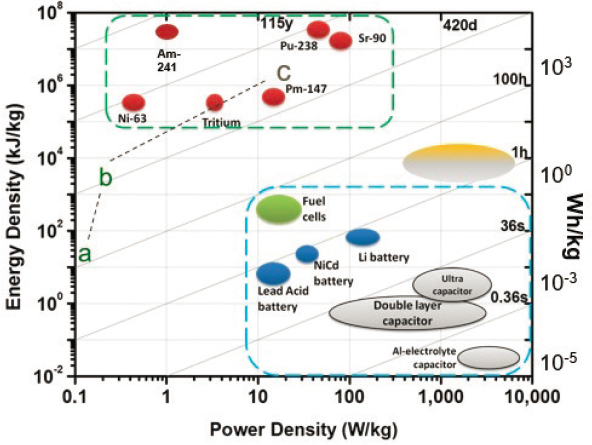
Incorporation of radioisotope sources entails accounting for heat produced by the radioactive materials in the design. In some environments, the excess heat might be welcome, in others, quite the opposite. Some materials, such as strontium-90, come with higher safety risks if dispersed, because of longer residence times when taken into a human body. Such materials could still be acceptable for unattended applications but should carry extra protection against dispersal of the radioactive material.14
Alongside the research problems of better integration of radioisotopes with semiconductors, the need for a reliable production-scale source of the radioactive substances should not be overlooked. Tritium is a good
___________________
14 M. Litz, R. Tompkins, S. Kelley, I. Kierzewski, and C. Pullen, U.S. Army Combat Capabilities Development Command (CCDC), Army Research Laboratory (ARL), 2020, “Radioisotope Power Sources—Technology and Applications: Maximizing Beta Interactions in Textured Energy Converters,” presentation to the committee on June 22.
prospect in this respect, as it will also be in demand in the near future for large-scale nuclear fusion experiments and is needed on a continuous basis to maintain nuclear weapon stockpiles. Tritium also has a short residence time in the body in case of inhalation or other forms of contamination. Basic research is under way in the United Kingdom and Japan with betavoltaics made by activation in nuclear reactors of dopants in chemical vapor deposition (CVD) diamond.15
The United States and the former Soviet Union both used RTGs to power unattended terrestrial navigational and communication sites in the past, and the devices are still important to space applications due to their ability to provide relatively low levels of power while approaching unlimited lifetime.16
Multi-domain operations will involve a proliferated network of persistent and mobile unattended sensors, processors, and communication devices. Radioisotope-driven power sources could enable long-lived persistent smart sensors—part of the incessant drive toward broad awareness (the Internet of Things [IoT], 5G, etc.)—where periodic battery replacement would become impractical.17
Successful device integration requires advancements in energy storage/power management (constant source, variable load); thermal management (especially stealthy heat rejection schema) to minimize signature; and advances in device energy efficiency and energy management (e.g., pulse communication) to utilize minimal power levels. While very small radiation sources have become routine in such applications as smoke detectors, larger quantities needed to produce useful electrical power would imply greater tracking, monitoring, and recovery protocols to avoid creating situations such as civilian discovery and unwitting radiation exposure from abandoned devices—as occurred in former Soviet Georgia in 2001.18
Dismounted Soldiers represent the greatest operational challenge in terms of enhancing capabilities without degrading capacity. Small radio-isotopic power sources could extend Soldier endurance, for example,
___________________
15 T. Wallace-Smith, “Diamond Batteries,” University of Bristol Institute of Physics, http://www.southwestnuclearhub.ac.uk, accessed May 26, 2020.
16 Miscellaneous Authors, Thermoelectric Generator, Science Direct, https://www.sciencedirect.com/topics/earth-and-planetary-sciences/thermoelectric-generator, accessed November 2020.
17 R. Walton, C. Anthony, M. Ward, N. Metje, D.N. Chapman, 2013, Radioisotopic battery and capacitor system for powering Wireless Sensor Networks, Sensors and Actuators A: Physical 203:405–412, https://www.sciencedirect.com/science/article/abs/pii/S0924424713004548.
18 NTI, 2002, “Radiothermal Generators Containing Strontium-90 Discovered in Liya, Georgia,” http://nti.org/4606A. https://www.nti.org/analysis/articles/radiothermalgenerators-containing-strontium-90-discovered-liya-georgia.
by charging batteries on the move, regardless of geography, weather, or time of day. The constant power-production aspect would require development of integrated energy management technologies, including electrical/thermal management, energy storage, flexible heat rejection methods, and signature mitigation. Moreover, while Soldiers already carry sensitive items such as weapons and communication devices, automated large-scale, real-time security/accountability methodologies would be important as in the case of unattended devices. From an energy-physics standpoint, development of a hybrid nuclear Soldier power device might involve investigation of phase change (thermal) versus capacitive (electrostatic) or battery (electrochemical) energy storage combinations; heat pipe, nanotube, or other small, flexible heat-transmission technologies; and novel (low observable) heat-sink geometries combined with emissivity-tuned coatings.
Modular architectures have been proposed to connect individual RTGs in a manner similar to electrochemical cells. Such a concept would allow for “stacking” of individual nuclear power supplies to support squad or platoon equipment when halted. Such a concept would require engineering and possibly research in order to enable both energy integration (especially cooling) of the modular unit and security, safety, and accountability issues.
It should be noted that the Army is already planning a project with 6.1 funding from now through fiscal year 2025 entitled “Fundamentals for Alternative Energy Applied Physics Research.” It entails “developing new methods for efficiently transforming energy-storing radioisotopes into a faster-release form for high power output.”19
Conclusion: The current level of study and development is appropriate to identify applications where a lightweight radioisotope decay system possibly coupled with a rechargeable battery could provide adequate power for present and future demands of the dismounted soldier. (Tier 2, Lead)
___________________
19 P. Schihl, 2020, U.S. Army CCDC Ground Vehicle Systems Center, spreadsheet provided to individual committee member.














